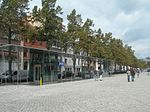Square Sainctelette
1911 in BelgiumCity of BrusselsSquares in BrusselsUse British English from October 2023

The Square Sainctelette (Dutch: Sainctelettesquare) is a square located in the City of Brussels municipality of Brussels, Belgium. It lies along the Brussels–Charleroi Canal, on the border with the Molenbeek-Saint-Jean municipality, from which it is separated by the canal. It is named in honour of Charles-Xavier Sainctelette, a former Belgian minister for public works.
Excerpt from the Wikipedia article Square Sainctelette (License: CC BY-SA 3.0, Authors, Images).Square Sainctelette
Porte du Rivage - Oeverpoort, Brussels Pentagon
Geographical coordinates (GPS) Address Nearby Places Show on map
Geographical coordinates (GPS)
| Latitude | Longitude |
|---|---|
| N 50.855555555556 ° | E 4.3469444444444 ° |
Address
Porte du Rivage - Oeverpoort
1000 Brussels, Pentagon
Belgium
Open on Google Maps









